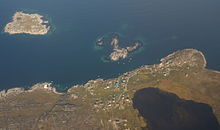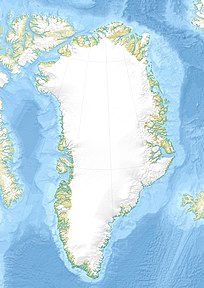Ilimanaq
| Ilimanaq (As expected!) | ||
|---|---|---|
| Claushavn Ilimanaĸ | ||
| Commune | Avannaata Communia | |
| District | Ilulissat | |
| Geographical location | 69 ° 4 '59 " N , 51 ° 6' 59" W | |
|
|
||
| Residents | 53 (January 1, 2020) |
|
| founding | 1741 | |
| Time zone | UTC-3 | |
Ilimanaq [ iˈlimanaq ] (according to the old spelling Ilimanaĸ ; Danish Claushavn ) is a Greenlandic settlement in the Ilulissat district in the Avannaata Kommunia .
location
Ilimanaq located on the Greenland mainland at the largely straight-running coastline on the eastern shore of the Disko Bay . The Ilulissat Icefjord (Kangia) separates the area around Ilimanaq from Ilulissat, 15 km to the north . Only five kilometers north of Ilimanaq is the abandoned settlement of Avannarliit , another kilometer to the north is the settlement of Eqi , which was abandoned in 1949 . Just off the coast of Ilimanaq are the three islands Ivissuartooq , Quilik and Affarleq . The place lies on a narrow 160 m wide strip, which is bordered in the east by Lake Tasersiaq .
history
Foundation phase
Ilimanaq is one of the oldest places in Greenland. The place name is an interjection derived from the verb ilimanarpoq (it can be expected), and therefore something like As expected! to translate. The Danish name Claushavn, however, honors the Dutch seafarer and whaler Klaes Pietersz. Thorp, who was active in Disko Bay between 1719 and 1732.
In the summer of 1736 Poul Egede , who was a missionary in the Christianshaab colony at the time , visited the area and met some Greenlanders who soon began to be interested in Christianity. For four years Poul Egede visited the place again and again and did missionary work and soon a small Christian community had formed.
In 1741 a 39 m² Greenland mission house was built and Ilimanaq became a mission box. In 1752 a storey house was built for the mission that had been transferred here from Christianshaab. In 1754 there were already 73 baptized people in Ilimanaq.
Later the Christianshaab colony's commercial assistant came to Ilimanaq every spring and lived there for a while. Still, Ilimanaq played no part in trade for a long time.
Whaling season
In 1780 Ilimanaq a whaling facility was built, which was named Isefjords Hvalfanger-Anlæg (whaling facility of the Icefjord). A 43 m² house was built in which an assistant and some sailors were stationed. In 1782 the facility was expanded. Two more storey houses with 110 m² each were built, plus a forge and a brewery. The men were supposed to go whaling in spring and autumn and mine for coal on Disco Island in summer . In 1783 a half-timbered bacon house was built on the offshore island. At first there was no economic success and so the activities were reduced in 1785, so that only five Danes were active in the plant. However, yields did not improve and only three whales were caught between 1786 and 1789. In 1792 consideration was given to giving up the facility, but this did not happen. In 1793 only the mission house and the bacon house were still in use. The mission went better than whaling. In 1793, 148 Greenlanders lived in Ilimanaq and nearby Inussuk in twelve houses, of which only three were unbaptized. In the mid-1790s the economic situation improved and ten whales were caught between 1794 and 1796. In 1805 Ilimanaq had 93 inhabitants. During the war from 1807 to 1814 whaling came to a standstill and did not recover afterwards. In 1826 the facility was abandoned, but the place was given the colony status of Christianshaab instead, where conditions were even worse. In 1829 this was reversed and Ilimanaq was returned to the status of a lodge. In 1830 a distillery was built. In 1850 141 people lived in Ilimanaq.
Ilimanaq as Udsted
From around 1880 Ilimanaq was an Udsted . Later there were flu and rose epidemics that killed many residents.
In 1915 Ilimanaq had 100 inhabitants. There were 14 apartment buildings. The Udsteds administrator's apartment was a one-storey house from 1752 with a garden, four rooms and a half-timbered extension that served as a kitchen. The provisions store was a storey building from 1741. It was 124 m² in size and had three rooms, one of which was used as a shop. In the past it was also used as a house for sailors. One bacon house was a half-timbered building, while the second bacon house was made of stone and was formerly used as a oil distillery. The church was from 1904 and was a half-timbered building with board cladding and roof shingles. It had a church tower, an iron chandelier, an altar panel with paintings and a gilt frame, and a harmonium . There was a school building of its own, which was also a timber-clad half-timbered building with roof shingles. 25 hunters, 14 fishermen, the Udsteds administrator, a catechist and a nurse lived in the village. It was reported that the hunters were extremely inept.
From 1911 Ilimanaq was the capital of a community to which the residential areas Avannarliit and Eqi belonged. The community belonged to the 4th district electoral council of North Greenland and was part of the colonial district of Christianshaab. Ilimanaq was part of the Qasigiannguit Catechetical District within the Ilulissat parish .
In 1928 a fish house was built in Ilimanaq. In 1930 there were already 321 people in Ilimanaq, but the number then fell sharply. In 1940 the place had only 127 inhabitants. In 1948 a new school was built. In 1950, 151 people lived in Ilimanaq again. In 1950 Ilimanaq was incorporated into the new municipality of Qasigiannguit . In 1952 there were 45 fishermen, but each caught an average of 2309 kg of fish. In 1960 the population had increased again to 254 people. In the late 1960s, the parish boundary was moved and Ilimanaq became a village in the Ilulissat parish . In 1970 there were only 168 people left in Ilimanaq.
List of colonial employees
Commercial assistants
The following commercial assistants were responsible for the administration of the Claushavn facility before it became an Udsted. From 1826 to 1830 the trade assistant was also the colonial administrator of the Christianshaab colony .
- 1780–1782: Ole Krabbe
- 1782–1784: Caspar Gottlieb Lidemark
- 1784–1786: Christen Andersen Enghel
- 1786–1787: Peter Lorentz Bang
- 1787–1788: Johann Friederich Lammerssen
- 1788-1791: Adam Christian Thorning
- 1791–1792: Joachim Holm
- 1792–1793: Rasmus Jensen Brandt
- 1793–1823: Johann Friederich Lammerssen
- 1823–1824: E. Jens Gottlieb Walerius
- 1824–1827: Carl Søren Vilhelm Egtved
- 1827–1830: Frederik Lassen
- 1830–1834: Søren Bruun Kornerup
- 1834–1837: Poul Georg Lauri Bolbroe
- 1837–1838: Hans Heinrich Muxoll
- 1838–1839: Poul Georg Lauri Bolbroe
- 1839-1843: Rasmus Møldrup
- 1843-1844: HN P Jørgensen
- 1844–1849: Peder Goische Kirchheiner
- 1849-1850: Lars Frederik Larsen
- 1850–1851: Einar Hansen
- 1851–1854: Eduard Gaspar Boye
- 1854–1856: Carl Emil Lange
- 1858–1867: Octavius Frederik Vilhelm Nielsen
- 1867–1869: Niss Lauritz Elberg
Missionaries and pastors
Between 1752 and 1792 Ilimanaq was the seat of the colony's missionary. Only briefly around 1780 was the colonial district taken over by the missionary of the Egedesminde colony . After 1792 the colonial district fell to the Jakobshavn colony .
- 1752–1780: Jens Pedersen Mørk (catechist)
- 1752–1754: Niels Brønlund Bloch
- 1754–1756: Peder Egede
- 1755–1757: Severin Thrane
- 1757-1758: Jacob Borch
- 1758–1765: Jens Rasmussen Stage
- 1765-1770: Caspar Drejer
- 1770–1778: Hans Egede Saabye
- 1781–1787: Caspar Grewe
- 1787–1792: Jens Koch Lintrup
doctors
Actually, the entire colonial district belonged to the Jakobshavn medical district . Nevertheless, three doctors were temporarily based in Ilimanaq.
- 1778–1781: Christlieb Wilhardius Fabricius
- 1827–1839: Johan Frederik Lerch
- 1830–1832: Johannes Haberdorff Lytzen
economy
Ilimanaq lives from hunting and fishing. However, there is no fish factory in the village. Tourism also plays a bigger role in Ilimanaq. Hikers often set out from here to Qasigiannguit or the Icefjord. Further employment opportunities can be found in the handicrafts, in the service industry, in trade, in schools or in administration.
Infrastructure and supply
The mooring conditions for boats in Ilimanaq are considered problematic. The port is in the south of the town. The village is supplied from the air via the Ilimanaq heliport in the northeast. There is a path in north-south direction in Ilimanaq, which connects the harbor with the heliport and from which small branch paths branch off.
Nukissiorfiit supplies Ilimanaq with electricity via a diesel power station, while the water supply is provided via the village lake. Oil stoves provide the houses, none of which are connected to a sewage network, with heat. Garbage is dumped in the north of the village. TELE Greenland is responsible for the telecommunications supply of Ilimanaq.
Development
Lars Hansenip Atuarfia teaches the children in Ilimanaq. There is an infirmary, a service building with laundry, workshop and opportunities for sporting activities, a Pilersuisoq branch, a meeting building and a football field.
Many of the buildings in Ilimanaq date from the early 18th century and are accordingly protected.
Sons and daughters
- Otto Sandgreen (1914–1999), writer, painter, pastor, catechist and teacher
- Jens Jørgen Fleischer (* 1948), dog sled driver, expedition traveler and author
Population development
The population of Ilimanaq has long remained constant at 80 to 90 inhabitants. From around 2010 the number of inhabitants fell sharply and is now around 50 to 60 people.

Web links
Individual evidence
- ↑ Map with all official place names confirmed by Oqaasileriffik , provided by Asiaq
- ↑ Ilimanaq at greenland-travel.dk
- ↑ a b c d e f Hother Ostermann : Beskrivelse af Distrikterne i Nordgrønland: Christianshaab District. De grandson Bopladser. Udstedet Claushavn . In: Georg Carl Amdrup , Louis Bobé , Adolf Severin Jensen , Hans Peder Steensby (eds.): Grønland i tohundredeaaret for Hans Egedes landing (= Meddelelser om Grønland . Volume 60-61 ). tape 1 . C. A. Reitzel Boghandel, Copenhagen 1921, p. 134 ff . ( Digitized in the Internet Archive ).
- ↑ a b Jens Christian Madsen: Udsteder and bopladser i Grønland 1901–2000 . Atuagkat, 2009, ISBN 978-87-90133-76-4 , pp. 133 f .
- ^ A b c Hother Ostermann : Beskrivelse af Distrikterne i Nordgrønland: Christianshaab District. History . In: Georg Carl Amdrup , Louis Bobé , Adolf Severin Jensen , Hans Peder Steensby (eds.): Grønland i tohundredeaaret for Hans Egedes landing (= Meddelelser om Grønland . Volume 60-61 ). tape 1 . C. A. Reitzel Boghandel, Copenhagen 1921, p. 123 f . ( Digitized in the Internet Archive ).
- ↑ a b c Ilimanaq at qaasuitsup-kp.cowi.webhouse.dk
- ↑ Population of Ilimanaq 1977–2020 at bank.stat.gl


